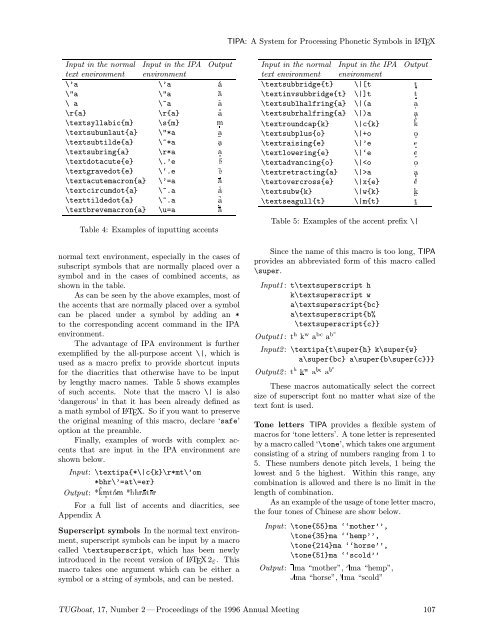TIPA: A System for Processing Phonetic Symbols in LATEX - TUG
TIPA: A System for Processing Phonetic Symbols in LATEX - TUG
TIPA: A System for Processing Phonetic Symbols in LATEX - TUG
You also want an ePaper? Increase the reach of your titles
YUMPU automatically turns print PDFs into web optimized ePapers that Google loves.
Input <strong>in</strong> the normal Input <strong>in</strong> the IPA Output<br />
text environment environment<br />
\’a \’a a<br />
\"a \"a a<br />
\ a \~a a<br />
\r{a} \r{a} a<br />
\textsyllabic{m} \s{m} m "<br />
\textsubumlaut{a} \"*a a<br />
\textsubtilde{a} \~*a a<br />
\textsubr<strong>in</strong>g{a} \r*a a<br />
\textdotacute{e} \.’e Ÿe<br />
\textgravedot{e} \‘.e že<br />
\textacutemacron{a} \’=a a<br />
\textcircumdot{a} \^.a a<br />
\texttildedot{a} \~.a a<br />
\textbrevemacron{a} \u=a a<br />
Table 4: Examples of <strong>in</strong>putt<strong>in</strong>g accents<br />
normal text environment, especially <strong>in</strong> the cases of<br />
subscript symbols that are normally placed over a<br />
symbol and <strong>in</strong> the cases of comb<strong>in</strong>ed accents, as<br />
shown <strong>in</strong> the table.<br />
As can be seen by the above examples, most of<br />
the accents that are normally placed over a symbol<br />
can be placed under a symbol by add<strong>in</strong>g an *<br />
to the correspond<strong>in</strong>g accent command <strong>in</strong> the IPA<br />
environment.<br />
The advantage of IPA environment is further<br />
exemplified by the all-purpose accent \|, whichis<br />
used as a macro prefix to provide shortcut <strong>in</strong>puts<br />
<strong>for</strong> the diacritics that otherwise have to be <strong>in</strong>put<br />
by lengthy macro names. Table 5 shows examples<br />
of such accents. Note that the macro \| is also<br />
‘dangerous’ <strong>in</strong> that it has been already def<strong>in</strong>ed as<br />
amathsymbolof<strong>LATEX</strong>. So if you want to preserve<br />
the orig<strong>in</strong>al mean<strong>in</strong>g of this macro, declare ‘safe’<br />
option at the preamble.<br />
F<strong>in</strong>ally, examples of words with complex accents<br />
that are <strong>in</strong>put <strong>in</strong> the IPA environment are<br />
shown below.<br />
Input: \textipa{*\|c{k}\r*mt\’om<br />
*bhr\’=at\=er}<br />
Output: *kmtom *bhrater<br />
For a full list of accents and diacritics, see<br />
Appendix A<br />
Superscript symbols In the normal text environment,<br />
superscript symbols can be <strong>in</strong>put by a macro<br />
called \textsuperscript, which has been newly<br />
<strong>in</strong>troduced <strong>in</strong> the recent version of L ATEX2ε. This<br />
macro takes one argument which can be either a<br />
symbol or a str<strong>in</strong>g of symbols, and can be nested.<br />
<strong>TIPA</strong>: A <strong>System</strong> <strong>for</strong> <strong>Process<strong>in</strong>g</strong> <strong>Phonetic</strong> <strong>Symbols</strong> <strong>in</strong> L ATEX<br />
Input <strong>in</strong> the normal Input <strong>in</strong> the IPA Output<br />
text environment environment<br />
\textsubbridge{t} \|[t t<br />
\text<strong>in</strong>vsubbridge{t} \|]t t<br />
\textsublhalfr<strong>in</strong>g{a} \|(a a<br />
\textsubrhalfr<strong>in</strong>g{a} \|)a a<br />
\textroundcap{k} \|c{k} k<br />
\textsubplus{o} \|+o o<br />
\textrais<strong>in</strong>g{e} \|’e e<br />
\textlower<strong>in</strong>g{e} \|‘e e<br />
\textadvanc<strong>in</strong>g{o} \|a a<br />
\textovercross{e} \|x{e} e<br />
\textsubw{k} \|w{k} k<br />
\textseagull{t} \|m{t} t<br />
Table 5: Examples of the accent prefix \|<br />
S<strong>in</strong>ce the name of this macro is too long, <strong>TIPA</strong><br />
provides an abbreviated <strong>for</strong>m of this macro called<br />
\super.<br />
Input1 : t\textsuperscript h<br />
k\textsuperscript w<br />
a\textsuperscript{bc}<br />
a\textsuperscript{b%<br />
\textsuperscript{c}}<br />
Output1: thkw abc abc Input2 : \textipa{t\super{h} k\super{w}<br />
a\super{bc} a\super{b\super{c}}}<br />
Output2: t h k w a bc a bc<br />
These macros automatically select the correct<br />
size of superscript font no matter what size of the<br />
text font is used.<br />
Tone letters <strong>TIPA</strong> provides a flexible system of<br />
macros <strong>for</strong> ‘tone letters’. A tone letter is represented<br />
by a macro called ‘\tone’, which takes one argument<br />
consist<strong>in</strong>g of a str<strong>in</strong>g of numbers rang<strong>in</strong>g from 1 to<br />
5. These numbers denote pitch levels, 1 be<strong>in</strong>g the<br />
lowest and 5 the highest. With<strong>in</strong> this range, any<br />
comb<strong>in</strong>ation is allowed and there is no limit <strong>in</strong> the<br />
length of comb<strong>in</strong>ation.<br />
As an example of the usage of tone letter macro,<br />
the four tones of Ch<strong>in</strong>ese are show below.<br />
Input: \tone{55}ma ‘‘mother’’,<br />
\tone{35}ma ‘‘hemp’’,<br />
\tone{214}ma ‘‘horse’’,<br />
\tone{51}ma ‘‘scold’’<br />
Output: € |ma “mother”, † |ma “hemp”,<br />
Š|ma “horse”, „|ma “scold”<br />
<strong>TUG</strong>boat, 17, Number 2 — Proceed<strong>in</strong>gs of the 1996 Annual Meet<strong>in</strong>g 107

















